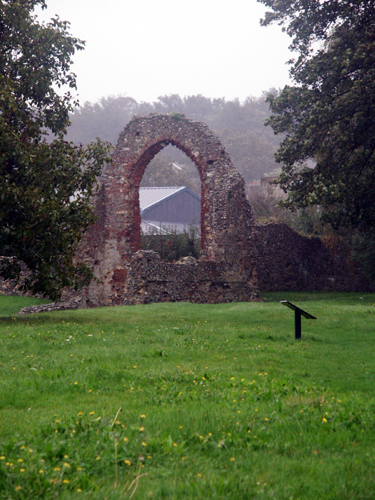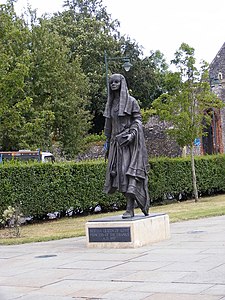St. Pancras Church, Canterbury, England
Probably built by Roman Christians, then taken over by pagans,
then re-consecrated by St. Augustine of Canterbury, then dissolved by King Henry VIII
St. Pancras was martyred in the persecution of Valerian (257 AD- 258) or in the persecution of Diocletian (304 AD - 306). Pancras's Latin name is Pancratius, which means a box for holding everything. St. Pancras's body was entombed in a catacomb on the Aurelian Way in Rome, and in the fourth century a church dedicated to St. Pancras was built above the catacomb. In 597 AD, Pope St. Gregory the Great presented St. Augustine of Canterbury with relics of St. Pancras, and then sent him to England to evangelize the pagan Anglo-Saxons. Aethelbert, the Anglo-Saxon king, was married to a Frankish (and Christian) queen, named Bertha, so it is perhaps not surprising that Aethelbert himself soon converted. The conversion of the king meant the conversion of all his subjects, so this was quite a coup for St. Augustine.
In his pagan days, Aethelbert had worshipped in his own pagan temple while Queen Bertha worshipped in her chapel. After his conversion, Aethelbert didn't need his pagan temple anymore, since he and Bertha could now worship together. So Aethelbert gave his old temple to St. Augustine, who consecrated it as a church in honor of St. Pancras. Before long, a monastery was added to St. Pancras, which became the burial place of Kentish kings. St. Pancras also became known as a seat of learning, with a very large library, as well as a place of pilgrimage, housing the preserved body of St. Mildred, which was reputed to work miracles. Nearly a thousand years after its establishment, King Henry VIII dissolved the monastery, whereupon its library and even its stones were plundered, and the entire grounds sank into bleak disorder, from which they have recently begun to be rescued. This statue of Queen Bertha has been erected on the former monastery grounds as part of a program to beautify them.
In his pagan days, Aethelbert had worshipped in his own pagan temple while Queen Bertha worshipped in her chapel. After his conversion, Aethelbert didn't need his pagan temple anymore, since he and Bertha could now worship together. So Aethelbert gave his old temple to St. Augustine, who consecrated it as a church in honor of St. Pancras. Before long, a monastery was added to St. Pancras, which became the burial place of Kentish kings. St. Pancras also became known as a seat of learning, with a very large library, as well as a place of pilgrimage, housing the preserved body of St. Mildred, which was reputed to work miracles. Nearly a thousand years after its establishment, King Henry VIII dissolved the monastery, whereupon its library and even its stones were plundered, and the entire grounds sank into bleak disorder, from which they have recently begun to be rescued. This statue of Queen Bertha has been erected on the former monastery grounds as part of a program to beautify them.
Bertha, Queen of the Anglo-Saxons
The beautification program obviously still has a long way to go.
In many parts of Europe, St. Mamertus, St. Pancras and St. Servatius are known as the Ice Saints because their feast days (May 11, May 12, and May 13) generally coincide with a spell of chilly weather. Some countries (Southern Germany, Austria, Northern Italy, Czech Republic) do not consider St. Mamertus an Ice Saint, so in these countries St. Pancras is the first Ice Saint.


No comments:
Post a Comment